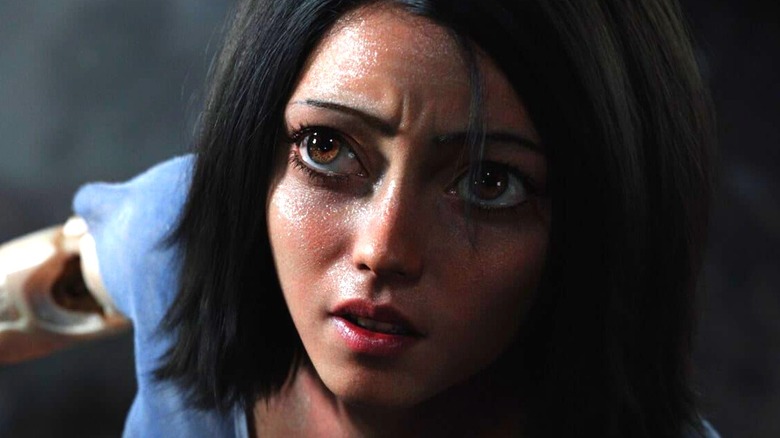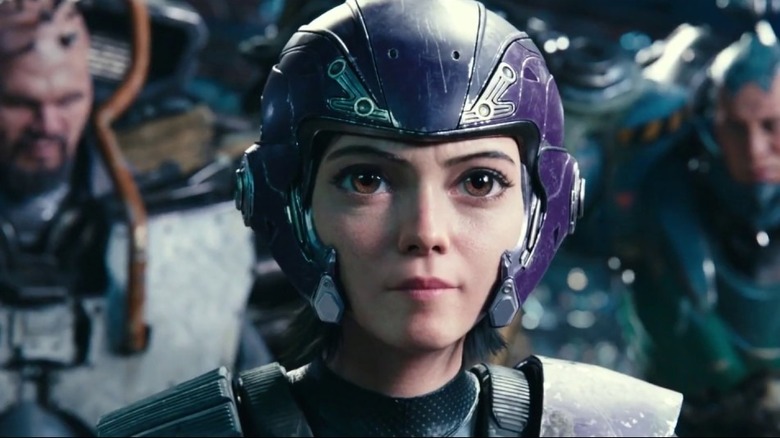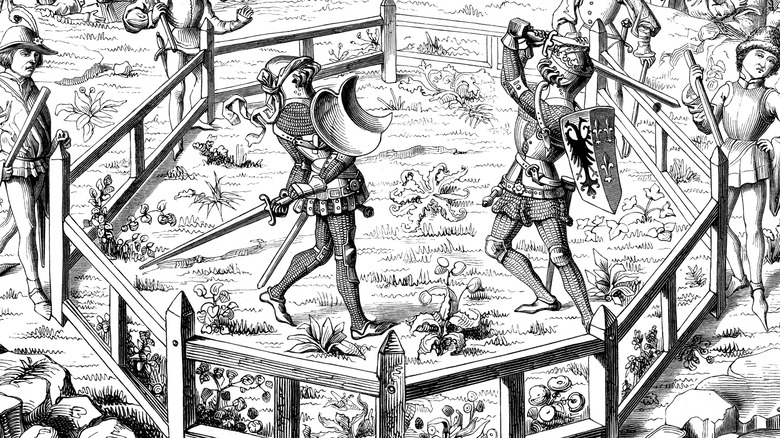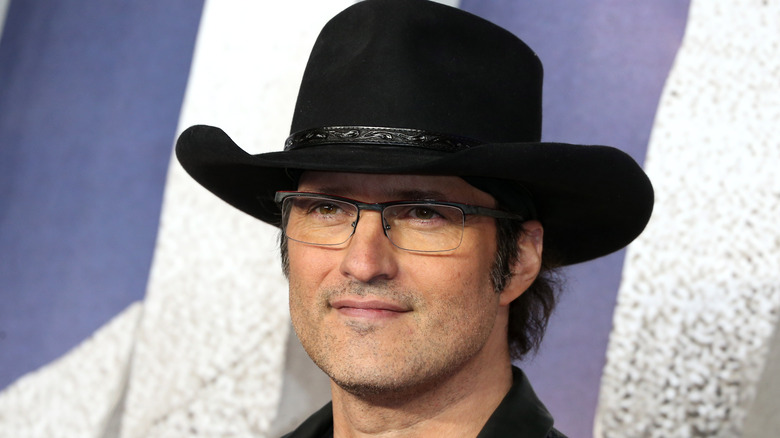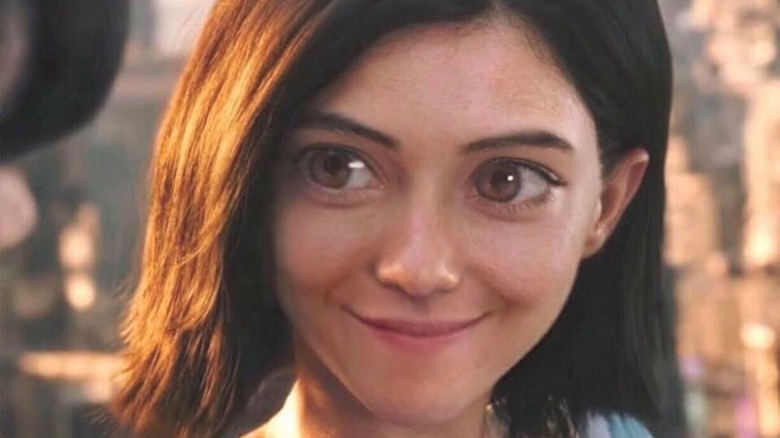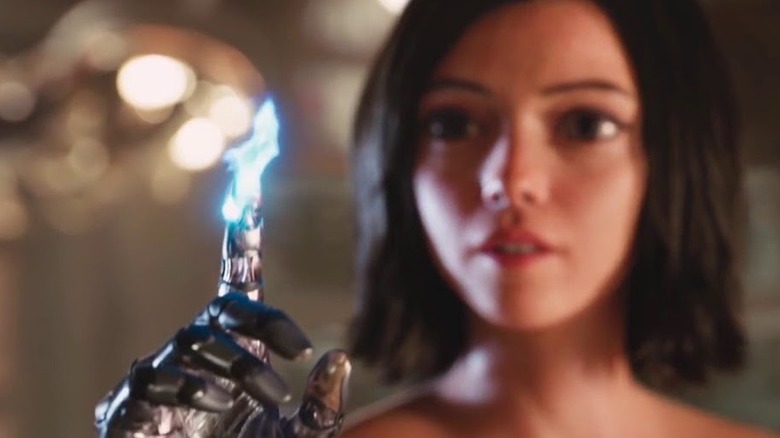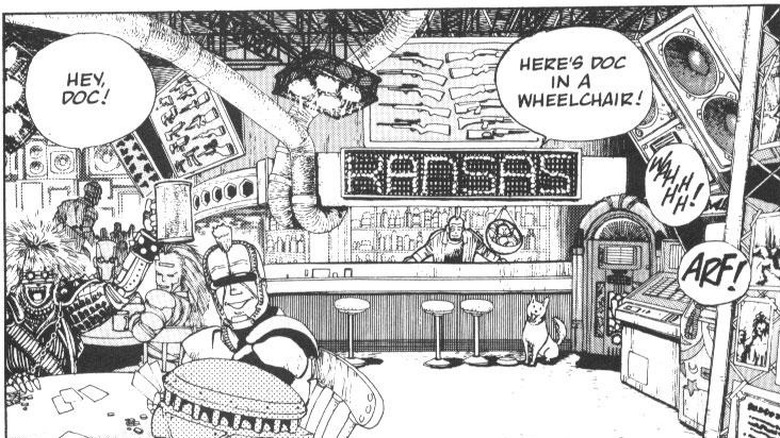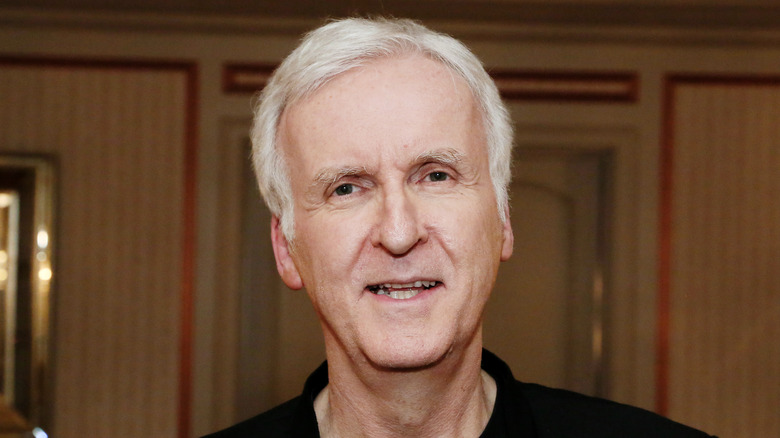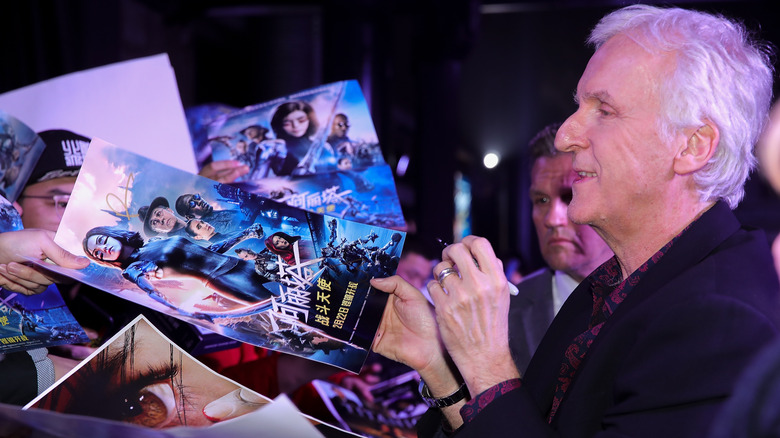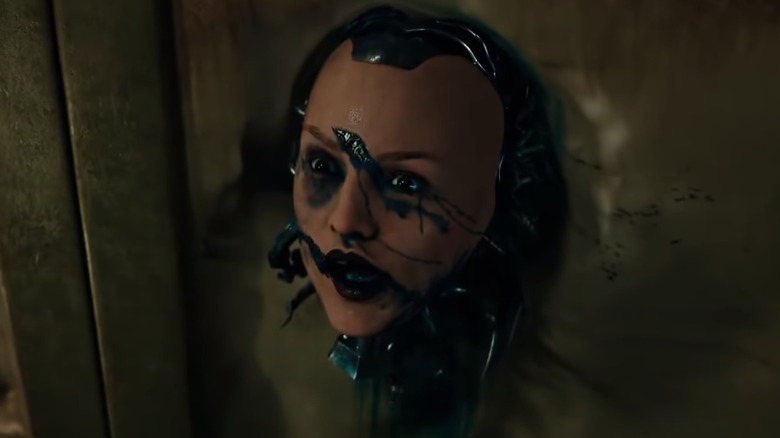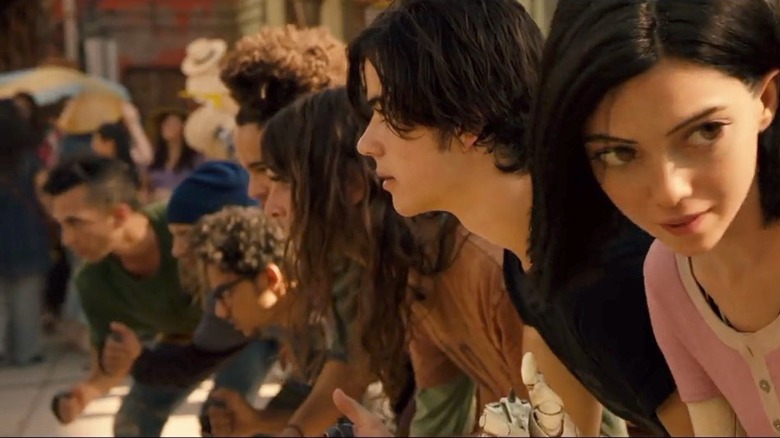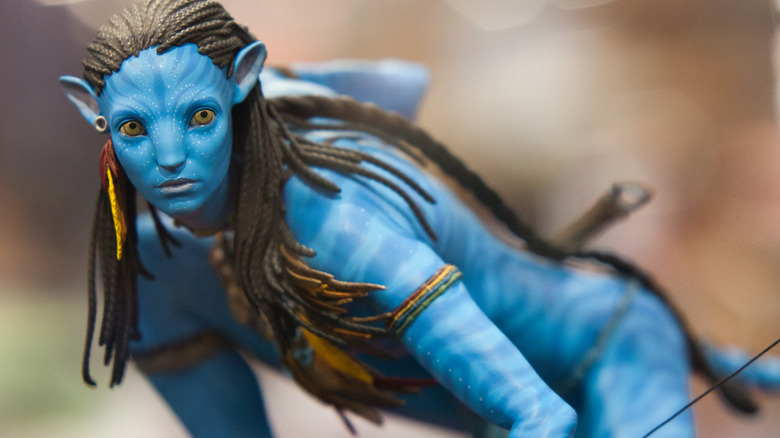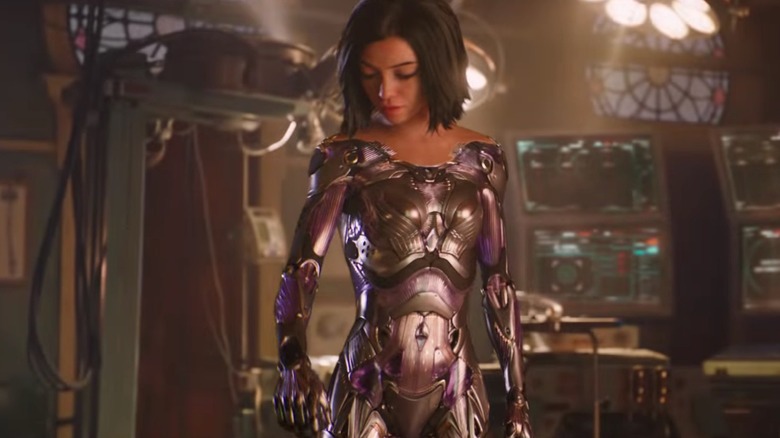Small Details In Alita: Battle Angel Only Real Fans Notice
With an expansive setting, rich source material to pull from, and an enormous $170,000,000 budget to splash around, "Alita: Battle Angel" is densely packed with details and layered world-building. Director Robert Rodriguez is widely considered an expert on keeping costs low, and his skills at being frugal likely stretched that budget as far as it could possibly go. Rodriguez's debut feature-film "El Mariachi" was made for the staggeringly low sum of just $7,000, a feat which he replicated recently with "Red 11," a semi-autobiographical story about the research testing he subjected himself to in order to raise the funds needed for "El Mariachi."
"Alita: Battle Angel" became Robert Rodriguez's highest budgeted film to date by an extremely large margin. With all that money — and with James Cameron on board as a screenwriter and producer — Rodriguez was able to flesh out the world of Iron City and pack the backgrounds with both live-action and CGI details. Let's take a look at some details you might have missed out on when watching "Alita: Battle Angel."
The motorball sequences use real camera physics
One of the most memorable and exciting parts of "Alita: Battle Angel" is the high-octane spectacle that is motorball. There are two motorball matches in the film, one a skirmish on the streets of Iron City, the second a professional tryout in a super-sized stadium. Despite the two motorball sequences being decidedly different when it comes to the tone, stakes, and even the visual presentation (with one being largely live-action and the other being largely CGI), both sequences use real-world camera physics.
Even though the limitations of real-world cameras do not apply when creating an action scene using CGI, Robert Rodriguez chose to self-impose those limitations to create a more grounded sequence. In an interview with Inverse, Rodriguez described his methodology for crafting this scene with a sense of realism. "I don't want the cameras flying around the place, doing things impossible to shoot," the filmmaker explained. "I wanted the physics of real cameras, placement you would see in NASCAR. Long lenses, capturing things whizzing by, as well as cameras on the track with the players to keep it as real world as possible."
Pulling inspiration from the shooting style of real-world sports and sticking only to shots that would be possible with a physical camera both serve to ground the bombastic action with a sense of reality.
Alita's fighting style stems from 15th-century sword fighting
Alita starts out the film as a total amnesiac. While struggling to recall details from her past, she finds herself stumbling into some dangerous situations. Luckily, she possesses an instinctive fighting style that kicks in when she's threatened.
Alita's fighting style is known as Panzer Kunst, a German term which translates into English as "Armor Art." Panzer Kunst comes directly from the manga series that inspired the film. Within the series lore, Panzer Kunst originated on Mars as a martial-arts style for use in zero-gravity combat.
In real life, Panzer Kunst refers to the art of defeating armored opponents in combat, fitting given that the majority of combatants in Alita are heavily armored cyborgs. The first descriptions of real-life Panzer Kunst in sword fighting are believed to come from the German fencing manual "Fechtbuch" from the 1440s. This instructional guide offered insights into fighting techniques to be used against both armored and unarmored opponents in a variety of combat situations. Though the manual was primarily focused on fencing, there were also techniques described for other weaponry and even unarmed combat. Given that Alita typically dispatches her foes with a mixture of her martial-arts abilities and her sword-fighting prowess, her fighting style lines up well with this 15th-century source of inspiration.
One of the lead actors had never been in a movie before
Keean Johnson, who plays Alita's friend and love-interest Hugo, made his big screen debut with "Alita: Battle Angel." Though the film came out in 2019, he had his first audition for the role all the way back in 2015. "I had never met with a director before," he told interviewer Dana Cortez. Making your big screen debut in a tentpole blockbuster is a feat few actors can claim.
When speaking with Fandango All Access, Johnson described the shoot as a whirlwind in which he went from working on TV here and there to working on one of the biggest movies in the world. On casting the part of Hugo, Robert Rodriguez said, "It's always fun trying to cast a cool character ... sometimes an actor will come in and they're playing cool. But this guy [Johnson] just was cool." Since his role in "Alita" in 2019, Keean Johnson has already gone on to appear in several subsequent projects, including the HBO series "Euphoria."
Alita's favorite food was made by Robert Rodriguez
After being brought back into consciousness for the first time in centuries by Dr. Ido, Alita is a blank slate. In her quest for self-discovery, Alita seeks to learn not just who she is, but also what she believes and what she likes and dislikes. When Hugo learns that Alita has never tasted chocolate before, he sets about remedying that fact immediately. After having chocolate for the first time, Alita declares that she now has a favorite food.
It might look like a simple chocolate bar, but it's actually a chocolate shell packed with a honey-peanut-butter filling and pecans. We know this because it was made by the director Robert Rodriguez himself, and he even made a tutorial explaining how to make your own at home. He used a 3D-printer to make a custom chocolate mold in the shape of the Zalem symbol found in the world of Alita. Rodriguez brought homemade snacks to the cast of the film as well (via Fandango All Access).
Throughout his career, Rodriguez's love of food has popped up in his work time and time again, as evidenced by his long-running "10-Minute Cooking School" series which often appears in the DVD and Blu-ray extras of his movies. He taught fans how to make Texas BBQ in the special features of the "Planet Terror" physical release. He gave his recipe for breakfast tacos in the "Sin City" bonus features. And he explained how to cook puerco pibil for the DVD release of "Once Upon a Time in Mexico," a dish which appeared in the film as a favorite of Johnny Depp's character Sands. As a bonus factoid, Rodriguez's "10-Minute Cooking School" is cited as a primary influence on the creation of the Binging with Babish cooking series on YouTube.
Alita wasn't always Alita
Long before the "Alita: Battle Angel" film was brought into existence, the story was first told in manga form all the way back in 1990. The first run of the manga series ran for nine volumes which were released over the course of five years. Multiple sequel series followed. In English, this manga by Yukito Kishiro is known as "Battle Angel Alita," though in Japanese, the title is "Gunnm," which translates directly as "Gun Dream." When speaking to BBC Radio 1, James Cameron described the title switch from "Battle Angel Alita" to "Alita: Battle Angel" as being a forward-thinking shift with sequels in mind. Cameron suggested potential sequel titles such as "Alita: Fallen Angel" and "Alita: Avenging Angel."
In the original manga and in the 1993 anime adaptation "Battle Angel," the main character's name was not Alita at all, but rather Gally. The name was changed for the initial English translation — a change that stuck around for the big-screen live-action adaptation in 2019. There is another important difference in Alita's namesake that changed between the manga and the film adaptation. In "Gunnm," Dr. Ido names Gally after his cat who recently passed away, while the live-action adaptation ups the ante and has Dr. Ido name Alita after his murdered daughter.
The flames that come out of Alita do more than you might realize
There are a couple of moments when little blue flames emerge from Alita's body. Though never explicitly explained in the film, those flames play an important role later on in the plot and serve an even more important role in the manga source material.
In the "Gunnm" lore, the little flames that come from Alita's body are an extension of her ability to manipulate plasma. What might look like a flame is actually arc plasma. Alita's arc plasma powers contribute to her fighting prowess by increasing her speed and magnifying the power of her strikes. When Alita throws a punch, it isn't just a synthetic fist striking her opponent, but also the destructive power of plasma energy.
Toward the end of the film when Alita finally gets her hands on the much sought-after Damascus Blade, her arc plasma abilities come into play again. You might notice that the blade turns blue and glows in Alita's hand, something it never did while in Zapan's possession. This is due to Alita's arc plasma powers surging through the blade, supercharging it.
The setting was changed from Missouri to Panama
One key location within Iron City where a great deal of action goes down is the Kansas bar. This bar comes straight out of the manga, but in the "Gunnm" lore, the name of the bar was a nod to the location that would eventually become Iron City centuries later: Kansas City Missouri. Author Yukito Kishiro intended Iron City to be a cultural melting pot with citizens from all over the world.
James Cameron realized that certain science-fiction aspects of this world — the space elevator to Zalem especially — made more logical sense if they were positioned closer to the equator and in a warmer climate. For this scientific reason, Cameron suggested changing the location of Iron City from Kansas City, Missouri, to Panama City, Panama. Robert Rodriguez loved the suggestion and rolled with it. Rodriguez was in favor of the change not just for the scientific reasoning, but also because Panama "is a Latin country, and we've never seen that in a sci-fi film before" (via CinemaBlend).
James Cameron was planning this film for nearly two decades
Though "Alita: Battle Angel" first hit theaters in 2019, James Cameron bought the film rights to the "Gunnm" manga all the way back in 2000. He even expressed interest in one day adapting the story as early as 1995 in advance of making "Titanic." The filmmaker was able to buy the adaptation rights directly from the manga's creator Yukito Kishiro for the sum of one million yen.
Cameron originally planned on directing the film himself, and considered going into production on "Alita" instead of "Avatar." Of course, that didn't end up happening. One key reason for holding off on "Alita" was that he didn't think CGI technology was quite ready to deliver what was needed to do "Alita" properly. After the massive financial success and major technological innovations of "Avatar," Cameron again toyed around with the idea of directing an "Alita" adaptation, but his attachments to the "Avatar" sequels made that impossible.
Robert Rodriguez, who had been a friend of Cameron's for many years and had seen materials from Cameron's earlier false-starts with "Alita," asked if the adaptation would ever happen if he was going to be busy with the "Avatar" franchise for the rest of his career. Cameron then offered Rodriguez the reins. "We had been looking for things to work on together for years," Rodriguez told Fandango All Access. "Alita: Battle Angel" made perfect sense for a collaboration between the two of them.
Cameron restructured the story of the Manga
When adapting a story that ran for nine full volumes in manga form, it's impossible to fit everything into a two-hour movie. Rather than simply cut material or limit the film to just the beginning of the "Gunnm" storyline, James Cameron opted to pick and choose moments from different volumes of the manga and restructure them in a way that told a cohesive cinematic storyline focused entirely on the journey of the titular character.
On adapting the manga, Cameron told film critic Ali Plumb, "I just treated it all as grist for the mill and tried to shape it into something that worked for a movie." Audiences "would be very disappointed if there was no motorball, so [Cameron] had to grab that from book four," Rodriguez told Crunchyroll. Cameron pulled material from different volumes of the manga to create a first draft of a screenplay that was around 180 pages long. With the help of Rodriguez and co-writer Laeta Kalogridis, the script was eventually whittled down to a more manageable length.
The color of the cyborg blood was changed
The blue blood of the cyborgs in "Alita" might feel reminiscent of other sci-fi properties, such as the inky-blue blood of the androids in Edgar Wright's "The World's End," but the blood in "Alita" wasn't always this color. In the 1993 anime adaptation "Battle Angel," the cyborg blood was a bright crimson color. And, although the manga was inked in black and white, there was a clear emphasis on gore that didn't make it into the 2019 live-action film.
In an interview with BBC Radio 1, James Cameron said, "I couldn't be 100% true to Kishiro's style because it's quite graphic and gory ... we sort of softened it a bit for a PG-13." Even with this softening, Alita pushes the limits of the PG-13 rating. There is plenty of mechanical destruction and dismemberment, a solitary F-bomb, and there's even a human who gets sliced in half and spills the red stuff. The MPA, formerly the MPAA, have historically been more lenient when assigning ratings to films with unnaturally colored blood. Tinting the cyborg blood blue helped the film slide past the MPA without landing an R rating and having the audience size significantly reduced.
"Alita: Battle Angel" isn't the first film directed by Robert Rodriguez to use unnaturally colored blood in a bid to get a lighter rating from the Motion Picture Association. 1996's "From Dusk Till Dawn" featured green blood for the vampires instead of red. The decision was made out of a fear of receiving an NC-17 label from the ratings board. The ruling landed in their favor, and "From Dusk Till Dawn" secured an R rating.
The neighborhood motorball match is filled with professional skaters
Alita gets her first taste of the motorball sport playing in a friendly neighborhood skirmish. As opposed to the later stadium motorball match, this first skirmish was intended to be executed with little-to-no CGI outside of the titular character. This requirement incurred a number of additional challenges, the first of which was finding the right talent to fill the roles of the other players, who had to play this larger-than-life game as if it was second nature.
Stunt coordinator Garrett Warren brought together the world's top professional in-line skaters to execute the scene. In a making-of video, Warren, producer Jon Landau, and members of the cast and stunt team discuss how the unique challenges of the scene were overcome. Tall drop-in ramps and mechanical winches were used to mimic the speed and momentum achieved by the motorized rollerblades of the film, which don't exist in real life.
James Cameron lent the Avatar design team to Alita
The special effects of "Alita: Battle Angel" are at the cutting edge of what's possible with modern filmmaking technology. Having a large budget wasn't all that it took to pull off the impressive visuals in "Alita" — it also took the best design team and technology available. Rather than scouring the industry for the best in the business, the necessary resources came from a little closer to home.
James Cameron had already assembled the perfect design team to work on the "Avatar" sequels, so when Robert Rodriguez got started on "Alita," Cameron lent him the team for a few months to work out the look, feel, and creation of the characters and world. The production also made use of the motion-capture and 3D camera technologies previously pioneered by Cameron for both the "Avatar" sequels and his documentary projects. Cameron wanted a realistic "nuts and bolts" look to the cyborgs and the world, while Rodriguez pulled from his experiences as a cartoonist to bring a lighter sense of style to the look and feel of the film. In working with the design team, a happy medium was found.
Alita's cyborg bodies are tailored to specific tasks
The only human part of Alita's physiology is her brain, while the rest of her body is synthetic. Even her heart is a pricey, centuries-old relic. This means that her body can be swapped out with different cyborg parts tailored to specific tasks. In the film, we see Alita in two main cyborg bodies — one a civilian body initially built in part for Dr. Ido's daughter before her death, and the other a reclaimed berserker body built for combat, plus a couple of quick glimpses at another cyborg body in flashbacks.
However, in the manga and anime, Alita has even more cyborg bodies she can switch between that are best suited to particular activities. Before the motorball match in the film, Dr. Ido insists that Alita wear protective pads on top of her Berserker body, but in the "Gunnm" lore, Alita has a specialized body made just for motorball. This motorball body has less destructive capabilities than her berserker body but is much faster and more flexible. If "Alita: Battle Angel" winds up getting a sequel, there's a chance we might see more of her specialized cyborg bodies.
